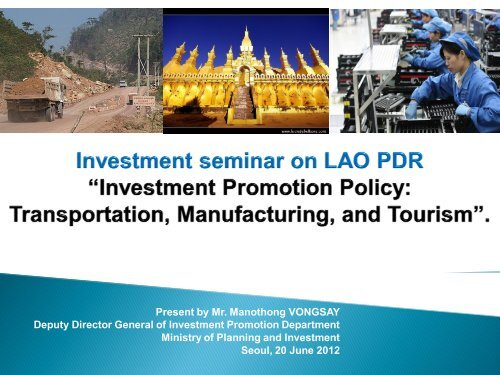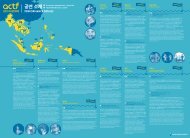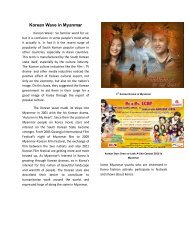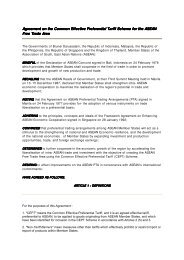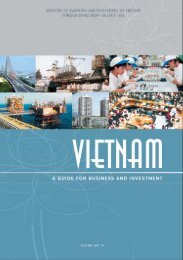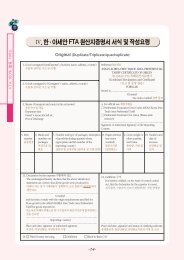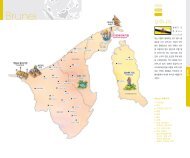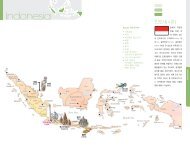Present by Mr. Manothong VONGSAY Deputy Director General of ...
Present by Mr. Manothong VONGSAY Deputy Director General of ...
Present by Mr. Manothong VONGSAY Deputy Director General of ...
Create successful ePaper yourself
Turn your PDF publications into a flip-book with our unique Google optimized e-Paper software.
<strong>Present</strong> <strong>by</strong> <strong>Mr</strong>. <strong>Manothong</strong> <strong>VONGSAY</strong><br />
<strong>Deputy</strong> <strong>Director</strong> <strong>General</strong> <strong>of</strong> Investment Promotion Department<br />
Ministry <strong>of</strong> Planning and Investment<br />
Seoul, 20 June 2012
1. Country snapshot<br />
2. Why invest in Lao PDR<br />
3. New Features <strong>of</strong> Investment Promotion Law<br />
4. Priority Investment Sectors<br />
4.1 Manufacturing Sector<br />
4.2 Tourism Sector<br />
4.3 Transportation sector<br />
4.4 Hydropower Sector
Land Area :<br />
236,800 sq. km<br />
Population : 6.5 Millions (2011)<br />
Population Density:<br />
26 people/sq km<br />
Population Growth: 2.3 %<br />
Labor Force:<br />
Religion:<br />
3.6 Millions<br />
Budhism
Strategic Location<br />
Laos is at the center <strong>of</strong> the GMS,<br />
consisting <strong>of</strong> Cambodia, Myanmar,<br />
Thailand, Vietnam, and Yunnan<br />
province <strong>of</strong> China.<br />
1. It is the only country bordering all<br />
the other countries in the subregion.<br />
2. More than 70% <strong>of</strong> international<br />
trade in Laos - except air freight<br />
is cross-border trade<br />
3. 50% <strong>of</strong> the Lao population lives<br />
in border districts.
Comparative & Competitive Advantages<br />
- Political stability<br />
- High safety<br />
- Low risk from natural disasters<br />
- Low labour cost<br />
Country <strong>of</strong> rich natural resources:<br />
Fertile land, Minerals, Water, and forest,<br />
giving development potential in<br />
agriculture, mining, and hydropower.<br />
5
One Stop Service Unit<br />
To fasten and facilitate investment procedures.<br />
The Government is creating a favorable business environment that is<br />
responsive to private sector needs.<br />
One Stop Service brings together representatives from all key<br />
ministries to facilitate investment applications and business start-ups<br />
Opened Ceremony on<br />
Oct 11, 2011<br />
6
Market Access<br />
Access to ASEAN market with more than 500 million inhabitants<br />
including southern part <strong>of</strong> neighboring China<br />
Connects Vietnam and Thailand through the East-West Corridor with<br />
Special Economic Zone in Savannakhet and through the 3 rd friendship<br />
bridge in Khammuan acting as trade and service centers<br />
• Unilateral Trade agreements with 39 countries<br />
including countries in EU, Japan, Canada,<br />
Australia, India, China and South Korea.<br />
• Bilateral investment treaties with more than 25<br />
countries from Europe to Asia<br />
• Easy regional access with regular direct flights<br />
to the major hubs <strong>of</strong> Bangkok, Hanoi, Kunming,<br />
Kuala Lumpur, Singapore, and Seoul.<br />
7
Combined the domestic investment law and foreign direct investment<br />
law into one to create a “level playing field” for both domestic and<br />
foreign investors;<br />
Shorten procedures to open new businesses;<br />
No terms <strong>of</strong> investment for promoted activities;<br />
Extended Investment incentives: Corporate income tax exemption up<br />
to 10 years, additional 5 years for Education and Health care sectors<br />
as top priorities;<br />
<br />
Foreigners can have access to local financial sources;<br />
<br />
Foreigners can invest in the real estate sector;<br />
<br />
Promotion <strong>of</strong> the development <strong>of</strong> SEZ and Industrial Park.
4.1 Manufacturing Sector<br />
4.2 Transportation Sector<br />
4.3 Tourism Sector<br />
4.4 Hydropower Sector
‣ Government Policy on manufacturing sector as<br />
clearly stated in the 7 th five-years plan (2011-2015):<br />
1. Promoting industrial processing in the agriculture sectors<br />
2. Promoting the wood processing industry.<br />
3. Promoting the garment and textiles industry<br />
3. Promoting the construction material industry<br />
‣ Number <strong>of</strong> factories has been increasing to<br />
about 37,690 factories in 2010, <strong>of</strong> which:<br />
1. Large size 218 factories<br />
2. Medium size 268 factories<br />
3. Small size 23,098 factories
‣ Comparative and Competitive Advantages:<br />
Low labor costs<br />
Available areas for investment (Industrial Parks and SEZs)<br />
High safety and Political stability<br />
Low risk from natural disaster<br />
Surrounded <strong>by</strong> 5 countries, which means bigger market<br />
size<br />
Center <strong>of</strong> logistics, supported <strong>by</strong> many bilateral<br />
agreements.<br />
Preferential Treatments or GSP given from various<br />
countries including EU, US, China, and Japan.
‣ Government promotional incentives:<br />
Import duties and tax exemptions on raw<br />
materials and capital equipment using<br />
for production<br />
Exemption from export duty on exported<br />
products<br />
Tax holidays <strong>of</strong>fered
The Lao government emphasizes infrastructure development sector<br />
as a crucial need.<br />
<br />
To provide an enabling, safe, and efficient transport throughout the<br />
country with low transport costs, to support the Government effort to<br />
graduate from LDC <strong>by</strong> 2020 and to achieve MDG <strong>by</strong> 2015”<br />
<br />
To transform from a land-locked country to a land-Link country <strong>by</strong>:<br />
◦ Providing efficient transportation infrastructures, and facilities,<br />
particularly on transit transport routes.<br />
◦ Facilitating cross border transport <strong>of</strong> goods and people between<br />
neighboring countries.
The 7 th Five-Year Transport Development Plan (2011-2015)<br />
<br />
Set a target budget allocation for infrastructure development projects at<br />
35%(Social35%, and economic30%).<br />
<br />
The important infrastructure projects for the next five years have been<br />
identified <strong>by</strong> the Ministry <strong>of</strong> Public Work and Transport.(MPWT),<br />
including:<br />
1. Road construction<br />
2. City planning and development<br />
3. Airports, logistics, etc.<br />
4. Upgrade and construct river ports, improve land and river transport<br />
services<br />
5. Construct railway line from Boten to Vientiane Capital, and carry out detail<br />
design <strong>of</strong> railway line from Thakaek to Mugia to connecting with<br />
Vietnamese Railway network.
No Name <strong>of</strong> railway Distance<br />
(KM)<br />
Amount<br />
(Billion US)<br />
Period<br />
1 Thanaleng-Vientiane 3.5 40 2008-2010<br />
2 Vientiane-Luangprabang-Boten 493 2,500 2010-2020<br />
3 Vientiane-Thakhek 325 1,400 2010-2020<br />
4 Thakhek-Mugia(Vietnam) 135 614 2010-2020<br />
Source: Ministry <strong>of</strong> Public Work and Transport 2011
No<br />
Name <strong>of</strong> the<br />
road<br />
Location<br />
Distance<br />
(KM)<br />
Remark<br />
1 National road 4B Hongsa-Xiengmen 128 NEDA is assisted in<br />
carrying out F.S<br />
2 Mekong Bridge Luang Prabang Proposed to NEDA for<br />
F.S<br />
3 National Road 1A Lantoui-Bounneua 142 Proposed for PRC s<strong>of</strong>t<br />
loan<br />
4 National Road 1E Khamkeut-Ngommalad 93 Contract Agreement<br />
being prepared for<br />
Local Private financing<br />
5 National road 17B Mouangsing-Xiengkok 97 This is the only road to<br />
connect with Myanmar<br />
6 Mekong Bridge Pak Beng proposed for PRC s<strong>of</strong>t<br />
loan
Tourism has gradually been raised<br />
important.<br />
The government has declared the<br />
implementation, development and<br />
promotion <strong>of</strong>:<br />
Cultural tourism<br />
Natural tourism<br />
Historical tourism<br />
Dedicated its efforts in developing<br />
infrastructures such as the construction <strong>of</strong><br />
roads linking all northern, central and<br />
southern parts.
1. Tourism Business is now opened to FDI with Foreign Equity <strong>of</strong> up to<br />
70%<br />
2. Extend more entry and exist checkpoints in various parts in order to link<br />
with many different countries, (15 international checkpoints at present.)<br />
3. Unilateral and bilateral Visa exemptions for several countries have been<br />
granted.<br />
4. Airport facilities have been upgraded.<br />
5. There are now 3 international airports in Vientiane Capital,<br />
Luangprabang and Pakse.
The National Tourism Authority (NTA) has<br />
cooperated with sectors concerned and local<br />
authorities to plan and develop national tourism sites.<br />
Up to present:<br />
Several natural tourist sites are welcoming FDI<br />
About 985 sites have been surveyed and identified.<br />
257 sites have been identified as cultural sites,<br />
570 as natural sites,<br />
162 as historical sites.<br />
364 sites are curently in service
With the surrounding emerging economies <strong>of</strong> China,<br />
Thailand, and Vietnam, electricity demand is expected to<br />
increase very rapidly.<br />
• With a potential <strong>of</strong> over 23,000MW <strong>of</strong> Hydroelectricity<br />
• Lao PDR planed to be the “Battery <strong>of</strong> Southeast Asia”<br />
• Abundant water resources produced <strong>by</strong> tributaries <strong>of</strong> Mekong river<br />
• Currently, only about 10% <strong>of</strong> its potential has been utilized(2,300MW)<br />
• GOL plans to increase its hydroelectric output to at least 1/3 <strong>of</strong> its<br />
potential <strong>by</strong> 2020.<br />
<br />
Laos has signed MOU to provide:<br />
• 7,000 MW <strong>of</strong> energy after 2015 to Thailand<br />
• 3,000 MW <strong>of</strong> electricity from present to 2020 to Vietnam
Table2. Hydroelectricity plan toward 2020<br />
Region No. <strong>of</strong> projects Output (MW) Production(GWh/y)<br />
Northern region 31 1,466 (2010-15)<br />
1,623 (2016-20)<br />
Central region 19 1,333 (2010-15)<br />
323 (2016-20)<br />
Southern region 27 1,047 (2010-15)<br />
905 (2016-20)<br />
Total 77 3846 (2010-15)<br />
2,851 (2016-20)<br />
8,016 (2010-15)<br />
7,783 (2016-20)<br />
5,366 (2010-15)<br />
1,524 (2016-20)<br />
6,504 (2010-15)<br />
4,729 (2016-20)<br />
19,886 (2010-15)<br />
14,039 (2016-20)
Thank you<br />
Investment Promotion Department<br />
Ministry <strong>of</strong> Planning and Investment<br />
Souphanouvong Avenue, Vientiane 01001,<br />
Lao PDR<br />
Tel: (856-21) 218377<br />
Fax: (856-21) 215 491<br />
22


